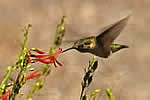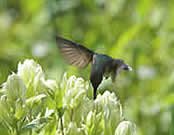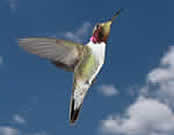USDA Forest Service Celebrating Wildflowers
|
|
|
Bird PollinationBirds are very important pollinators of wildflowers throughout the world. In the continental United States, hummingbirds are key in wildflower pollination. In other areas, honeycreepers (Hawaii) and honeyeaters (Australia) are important pollinators. In addition, brush-tongued parrots (New Guinea) and sunbirds (Old World tropics) serve as tropical pollen vectors. There are 2,000 bird species globally that feed on nectar, the insects, and the spiders associated with nectar bearing flowers. Bird FlowersThe flowers that are visited by birds and hummingbirds are typically:
Hummingbirds have very good eyes and are extremely attracted to red. They thrust their long slender bills deep into the flowers for nectar, withdrawing faces dusted in pollen. Although a hummingbird weighs between two and eight grams (a penny weighs 2.5 grams), they eat frequently in order to power hearts that pump 1,200 times per minute and wings that beat seventy times each second. To survive, they must eat several times their weight in nectar everyday! For protein, they supplement their sugary diet with small insects. In the eastern United States, there is only one kind of hummingbird, the ruby-throated hummingbird. In the southwestern states, birdwatchers can find a dozen species of hummingbirds.
For More Information
Fun FactThe white wing dove is also an important pollinator. According to the Arizona-Sonora Desert Museum, the doves synchronize their migration into the Sonoran Desert with the reproductive cycle of saguaro cactus. White-winged doves are important to saguaros as pollinators but they are also the main seed predators of saguaros. This is an interesting ecological balance. |
|
| Ants | Bats | Bees | Beetles | Birds | Butterflies | Flies | Moths | Unusual | Wasps | Wind & Water | |
| NOTE: PDF format links require the Adobe Acrobat Reader to view. | |
| top | Disclaimers | FOIA | Privacy Policy | Quality of Information | Photo Credits & Use |
Location: http://www.fs.fed.us/wildflowers/pollinators/birds.shtml
Last modified: Tuesday, 20-May-2008 15:56:10 EDT






